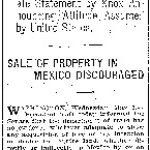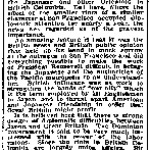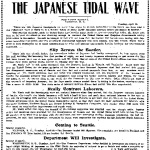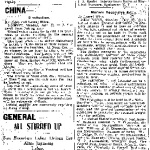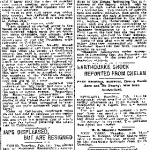California Joint Immigration Committee
The successor organization to the Japanese Exclusion League, the California Joint Immigration Committee (CJIC) continued its anti-Japanese activities after Japanese exclusion was secured in 1924 and advocated mass removal and incarceration of Japanese Americans during World War II. Groups like the CJIC provide a tangible link between the anti-Japanese movement of the 1920s and the mass exclusion policy of World War II.
Formation and 1930s Activity
The Japanese Exclusion League of California was formed at a meeting on September 2, 1920, in San Francisco, with the purpose of seeking legislation that would end further Japanese immigration to the United States. Its president was State Senator J. M. Inman and officials of the Native Sons, American Legion, California State Federation of Labor, California State Federation of Women's Clubs, California State Grange, Farm Bureau and Loyal Order of the Moose were vice-presidents. However, according to historian Roger Daniels, the "real power in the organization" was wielded by V. S. McClatchy , a wealthy retired newspaper publisher who led the exclusion movement. [1] In an effort to remove the taint of racism from the movement, McClatchy later decided to downplay the role of the League, making the focus on immigration reform in a more general sense. After the passage of the Immigration Act of 1924, which did end Japanese immigration, the California Joint Immigration Committee was formed as a successor to the Exclusion League. McClatchy would lead the organization until his death in 1938.
The CJIC continued to monitor Japanese American issues, working to insure that the exclusion law would not be overturned, seeking to extend alien land laws into states that did not have them, and even having passages that were favorable to Japanese Americans removed from textbooks in California and Hawai'i. [2] The organization also targeted other non-white immigrant groups, in particular immigrations from the Philippines and Mexico. But the group's effort to deny Mexican immigrants the right to naturalization failed. [3]
World War II
The CJIC saw the attack on Pearl Harbor as an opportunity to further their anti-Japanese efforts. As CJIC executive secretary H. J. McClatchy (the son of V. S.) put it at the group's February 7, 1942, meeting, "I know that the Committee has received more active and more general support in the last month than it has received in the last thirty years of its existence, and what we want, we ought to get now." Committee member Charles M. Goethe was even more blunt: "This is our time to get things done that we have been trying to get done for a quarter of a century," he told the group. [4]
Somewhat predictably, the CJIC sent out a release decrying Nisei dual citizenship and charging that Japanese Americans engaged in fifth column activity in Hawai'i. They later put out a statement advocating mass removal of Japanese Americans, since "it was impossible to separate the loyal from the disloyal. While the loyal might therefore suffer in mass treatment, this was preferable to endangering the welfare of the nation." [5] The CJIC was also among the groups that opposed the repeal of Chinese exclusion in 1943. The CJIC continued its agitation after the war, supporting California's Proposition 15 in 1946, which would have made the alien land law a part of the state constitution, though its influence, as with other anti-Japanese organizations, waned dramatically subsequently. [6]
For More Information
California Joint Immigration Committee Collection, 1924-1936. Bancroft Library. University of California, Berkeley.
Daniels, Roger. The Politics of Prejudice: The Anti-Japanese Movement in California and the Struggle for Japanese Exclusion . 1962. 2nd edition. Berkeley: University of California Press, 1977.
Grodzins, Morton. Americans Betrayed: Politics and the Japanese Evacuation . Chicago: University of Chicago Press, 1949.
Molina, Natalia. "'In a Race All their Own': The Quest to Make Mexicans Ineligible for U.S. Citizenship." Pacific Historical Review 79.2 (May 2010): 167–201.
Footnotes
- ↑ Roger Daniels, The Politics of Prejudice: The Anti-Japanese Movement in California and the Struggle for Japanese Exclusion (1962, 2nd edition, Berkeley: University of California Press, 1977), 91.
- ↑ Commission on Wartime Relocation and Internment of Civilians, Personal Justice Denied: Report of the Commission on Wartime Relocation and Internment of Civilians (Seattle: University of Washington Press, 1997), 36.
- ↑ Natalia Molina, "'In a Race All their Own': The Quest to Make Mexicans Ineligible for U.S. Citizenship," Pacific Historical Review 79.2 (May 2010): 182–84.
- ↑ Morton Grodzins, Americans Betrayed: Politics and the Japanese Evacuation (Chicago: University of Chicago Press, 1949), 20.
- ↑ Grodzins, Americans Betrayed , 47.
- ↑ Kevin Allen Leonard, "'Is That What We Fought For?' Japanese Americans and Racism in California, The Impact of World War II," The Western Historical Quarterly 21. 4 (1990), 471. Proposition 15 was voted down by California voters in November 1946, the first time an anti-Japanese ballot initiative was rejected in California. Writing in 1948, Nisei journalist Larry Tajiri claimed that organization " exists today only in the letter writing proclivities of... H. J. McClatchy." See Larry and Guyo Tajiri, Pacific Citizens: Larry and Guyo Tajiri and Japanese American Journalism in the World War II Era, edited, with an introduction and notes by Greg Robinson (Urbana: University of Illinois Press, 2012), 201.
Last updated Dec. 13, 2023, 6:02 p.m..

